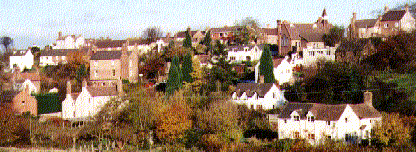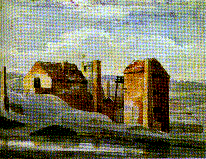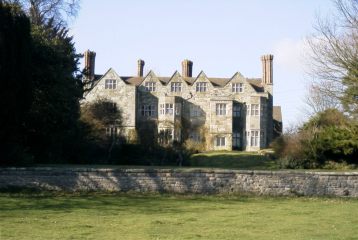The twisting lanes and haphazard buildings of Broseley hardly bear just witness to the town’s historical significance. This is the original town of the Shropshire coalfield. It is the area where the first commercial Watt blowing engine was erected, the first iron boat built, most of the country’s clay pipes made and one of the world’s first flanged wheel railways ran. There are few industrial monuments left in the town to these achievements and the people involved in them. It is the old houses and workshops, and the tracks and mounds in the landscape that survive, reflecting the casual way in which industry developed and declined within this small community.
Broseley originates in a Saxon clearance within the Royal Forests which covered most of the Ironbridge Gorge. The form of medieval Broseley survives around the church. Although no church was recorded in the Doomsday survey, the presence of ox-teams suggests quite an important agricultural settlement. Aided by the sale of land by Much Wenlock abbey with the dissolution of the monasteries, the coal and iron trade started to develop in the sixteenth century.
In the early seventeenth century Broseley comprised virtually two settlements. The centre was around the church at the eastern end of the modem town, where there were two small greens, a pond and a hail. The present day Church Street was faced with buildings for less than half its length and High Street was an open track up Cole Pitt Hill. Extending from the brow across to Broseley Wood there were scattered houses set in their own fields. The parish used to extend down to the riverside settlement of Jackfield with its early pottery works. Exposed timber framing can be found at the back of several buildings in these areas, where much structural timberwork has been hidden by later brick walling.
With all the works, apart from Onions’ foundry, sited on the edge or away from the village, Broseley was able to develop as an urban centre for the coalfield. It had started to grow rapidly in the sixteenth century, as James Clifford encouraged miners to build squatter cottages on the old manorial commons. The arrival of the new settlers, who were described as the ‘dregs of many counties’, prompted rioting by the local townspeople. The town comprised around 27 houses by 1620 with possibly 33 more standing on Coalpit Hill, the area now covered by King and Queen Streets.
Cole Pitt Hill became the High Street, lined with shops and the town hall. The ironmasters with works on the south side of the river took over or built themselves large houses in Broseley, attracted by the presence of a church, chapels, a market and shops, and by their aspirations towards urban gentility. The Georgian residences of Church Street and High Street are impressive but betray the hand of local architects in their curious proportions, rough brickwork and unsympathetic alterations.
Only the Shrewsbury architect, Thomas Farnolls Pritchard, achieved a classical correctness, with his designs for Old St. Mary’s Jackfield and chimney-pieces in Benthall Hall, Broseley Hall and the Lawns. It was Pritchard who initiated and produced the first designs for the Iron Bridge, erected in 1779.
The advance in social status of the industrialists was accompanied by the growth of dissenting religion. The Quakers built a meeting house in Broseley which was attended by Abraham Darby I when he was living in Coalbrookdale. The Baptists and Congregationalists came to be represented but it was the Methodists who were to emerge as the strongest group in the nineteenth century.
The prosperity of the iron industry was short-lived. From the beginning of the nineteenth century the iron and especially the coal seams were becoming exhausted. Willey furnace went out of blast in 1804. By the 1840s Onions’ foundry was the only ironworks left on the south side of the Severn. The industry had largely moved to Staffordshire and Worcestershire while Peter Onions, John Guest and the Homfhrays had left for South Wales
Buildings and JittiesThe Victorian houses and shops largely perpetuate established plans and forms, being given a Tudor style through pronounced gables, dormers and hoodmoulds. What is so memorable is the display, applied to both Victorian and earlier buildings, of the range of architectural ironwork and ceramics being produced locally. Cheaply or even freely available, these materials are used widely and with some ingenuity. Not only railings and fanlights are cast in iron but also gate caps, window lintels and graveslabs. Similarly the local mottled bricks and strawberry-coloured tiles are decorated with an endless variety of ornamental bricks, ridge tiles, finials and chimney pots. Decorative tiles designed for chancel floors and pub walls are to be found on the sides of buildings and in their porches and pathways. Even saggars, firebricks and slag, the waste products of local industry, were used for rough walling.
 As the coalfield
developed around the turn of the seventeenth century James Clifford provided plots for
immigrant miners to build their own homes. This is particularly apparent in Broseley
Wood (illustrated left) where there developed a maze of cottages lining an
irregular network of lanes and enclosed footpaths. Locally these are known as Jitties. In
recent years the Jitties have been restored under a conservation programme. The overall
effect is one of intricacy and slight confusion; a heritage that is both appealing and
highly evocative of Broseley’s historical importance.
As the coalfield
developed around the turn of the seventeenth century James Clifford provided plots for
immigrant miners to build their own homes. This is particularly apparent in Broseley
Wood (illustrated left) where there developed a maze of cottages lining an
irregular network of lanes and enclosed footpaths. Locally these are known as Jitties. In
recent years the Jitties have been restored under a conservation programme. The overall
effect is one of intricacy and slight confusion; a heritage that is both appealing and
highly evocative of Broseley’s historical importance.
The impetus to early industry was the abundance of coal, clay, iron ore
and limestone easily workable in one area.. Meanwhile the woods provided charcoal and the
River Severn cheap transport. James Clifford, lord of the Manor of Broseley in the late
sixteenth century, was one of the pioneering industrialists, operating mines and wooden
railways. John Weld owned part of the Manor of Broseley in 1620 and operated a blast
furnace at nearby Willey. The mines in Broseley and the adjoining parish of Benthall
became of national importance in the seventeenth century. Wooden railways were built both
to bring coal out of mines and to carry it down the sides of the Severn Gorge to the
river. A document of 1605 refers to a line from Birch Leasows, Broseley to the Calcutts;
this is only the second railway for which evidence survives in England. By the 1630s such
lines were being built down many of the tributary valleys leading to the river. The major
ironworks were all situated off the plateau on which Broseley was growing, beside
tributaries of the River Severn. Waterwheels were used to operate the bellows before steam
engines were installed. A new furnace was built at Willey in 1758 by the New Willey
Company the most important partner in the company being John Wilkinson. Wilkinson was born
in Cumbria into a family involved in the iron trades he had works at Brymbo near Wrexham
and at Bradley in Staffordshire. He bought a house in Broseley and made most of his
innovations in the manufacture and use of iron in Shropshire. After he discovered a better
way of boring cylinder tubes there followed a long association with Boulton and Watt of
Birmingham. The first Boulton and Watt steam engine to be sold from their works was
installed at Willey to operate the bellows of the blast furnace. Wilkinson made the first
iron boat which was launched on the river Severn at Wiley Wharf and is reputed to have
made the first coal cutting machines . He was an astute businessman and gained good
profits out of steam engines and government orders for cannon.
The Calcutts, Benthall and Coneybury furnaces all came into blast in the latter half of the eighteenth century. John Onions had gained control of the Coneybury furnace (illustrated left) by 1800 and then took over the Broseley furnace built by John Guest (who later founded what was to become GKN) in 1806 by the Coalport Road. Onions also built a large foundry just to the south of Church Street. There were also two furnaces on the banks of the Severn at Barnetts Leasow blown by a Watt engine. These were built by Jesson & Wright who were ironmasters from West Bromwich and supplied their forges a few miles further down the Severn at Wrens Nest. Calcutts and Benthall ironworks were used for Earl Dundonald’s experiments in combining coke and tar production; the process appears to have been more of a technical than an economic success.
Mining south of the Severn and its remains
Astley Fields Colliery
Barn Fold Benthall
Birch Meadow Colliery
Coneybury Colliery
Cockshutt Lane Colliery
Cockshutt Lane Ironstone Mine
Haycop and Bottom Coal Mines
Stable Hill Mine
Three Stile Piece-Yewland Mine
 There were hundreds of individual pipe makers in
Broseley many of whom used their own stamps. In the nineteenth century pipemaking became
concentrated in factories of which there were three:- at Bridge Bank, Benthall;
Legge’s Hill and on King Street, where the former works of William Southorn & Co.
survives substantially intact. This company had been established in 1823 and by 1890 the
factory employed 90 people. The Southorn family still produce clay pipes and a display of
their products along with original Coalport china can be seen at the Cumberland Hotel.
"Will you take a Broseley?" became a familiar phrase to smokers in an era when a
clay pipe of tobacco could be purchased across the bar of a tavern. The remaining
pipe works is now open as a museum
run by the Ironbridge Gorge Museum and open 7 days a week from March to
October.
There were hundreds of individual pipe makers in
Broseley many of whom used their own stamps. In the nineteenth century pipemaking became
concentrated in factories of which there were three:- at Bridge Bank, Benthall;
Legge’s Hill and on King Street, where the former works of William Southorn & Co.
survives substantially intact. This company had been established in 1823 and by 1890 the
factory employed 90 people. The Southorn family still produce clay pipes and a display of
their products along with original Coalport china can be seen at the Cumberland Hotel.
"Will you take a Broseley?" became a familiar phrase to smokers in an era when a
clay pipe of tobacco could be purchased across the bar of a tavern. The remaining
pipe works is now open as a museum
run by the Ironbridge Gorge Museum and open 7 days a week from March to
October.
Pottery making remained a major industry well into the nineteenth century and became concentrated by the river in Jackfield. However there were several factories in Broseley. Remains of the Salopian Art Pottery survive at the site of the Benthall drainage pipe factory by the Much Wenlock road. Another factory was located across the road and further evidence of a pottery has been found at Benthall Old Vicarage. Many works were producing the type of yellow and brown slipped pottery with a pie crust edge, often found in local gardens
As well as common domestic pottery Broseley became famous for the production of fine porcelains with blue and white decoration. The earliest china factory was located at Caughley at the end of Pound Lane, where a pottery had been working since at least 1750 producing course and slip wares .
In 1772 Thomas Turner came from Worcester to run the factory where he experimented with new types of fabric and decoration. By 1775 he was producing porcelain. John Rose left Caughley in the 1790's and, with others, set up a pottery on land then being developed on the north bank of the river at Coalport. This venture developed into the Coalport China Works, famed for its output of highly decorative table and ornamental ware. The Caughley works was eventually taken over by the Coalport Company in 1799, probably because of the ill health of Turner . In 1821 the works were dismantled and the materials re-used at Coalport. The site was opencast for coal in 1964 destroying any archaeological remains, however there are remains of the saggar works which were located in a field just to the south of the works.
40 Years at the Potters Wheel - Benthall Potteries 1937
Bricks, Roof and Decorative Tiles
By the 1880s a Broseley’ might have meant a roof tile rather than a smoking pipe. For over a hundred years Broseley was famous for the manufacture of very hard, dark purple roof tiles. The secret of the tiles was the deep clay found in the Jackfield area. By 1840 there were at least eight large works dispatching tiles all over the country via the River Severn.
The first encaustic tiles were not in fact made by the better known factories, but by Exleys roof tiles firm in the 1830s. In 1852 Maw and Company moved to Benthall to save the cost of shipping clay downstream to their works at Worcester. They opened a works at Jackfield in 1883, where the other decorative tile firm, Craven Dunhill (now a nuseum), had established itself in the early 1870s. Using the Severn Valley Railway, they supplied an enormous range and quantity of tiles across Britain and to most parts of the world. At the turn of the century there were at least ten other firms making bricks and roofing tiles in the area, Broseley Tileries being on the outskirts of the town. ‘Broseley Tiles’ became a term associated with the highest quality strawberry-coloured roof tiles.
St. Mary’s Church, Jackfield, designed by Arthur Blomfield in 1863, is a showpiece of local brick and roof tiles, and inside, of decorative tiling. The chancel contains floor and wall tiling by Maw and a reredos by Craven Dunhill.
George and Arthur Maw, William Exley and Captain Prestage in part took over the roles
that the ironmasters had played in Broseley's life. But the economic effect of the brick
and tile trade was only to alleviate the decline caused by the collapse of the iron and
coal industries. The population of the town dropped by a fifth during the nineteenth
century. The Pritchard Memorial was virtually the only manifestation of any continuing
civic aspirations
Astley Abbotts Brickworks
Coalmoor Sanitary Pipe Company
Coalport Tileworks - Enoch Hopley
Cockshutt Lane - Fishouse Brickworks
Craven Dunnill - Early History
Dunge Brick and Tile Works
Easthope Coppice Brickworks
Hollywell Tileries
Madeley Wood Brick and Tile Works
Tweedale Brick and Tile Works
Tuckies Brickworks
SHROPSHIRES ONCE-FAMOUS ROOFING TILE INDUSTRY AT A STANDSTILL Wellington Journal 31st August 1946 Benthall
Benthall was once a thriving coal mining settlement but reserves were worked out at an early date and the parish reached its highest population in 1801. The monks of Buildwas obtained limestone from quarries on Benthall edge, an industry which continued to operate until the 1920s. There are remains of limekilns at Bower Yard, in Spout Lane and amongst the quarries themselves. In the late eighteenth century the Benthall valley, running down to the Iron Bridge, was the site of a large ironworks with associated boring mill. A series of pools provided power for the ironworks and several mills including the one which survives in ruins at the bottom.
Benthall Hall Built c. 1580 on or near the site of a manor of at least 12th century and possibly
Saxon origins, the estate having been held c. 1100 by Anfrid de Benetala. In 1283 the
estate, being without male heir, passed to a member of the powerful Burnell family who had
married one of Anfrid’s descendants. This branch of the two families later reverted
to the Benthall name.
Built c. 1580 on or near the site of a manor of at least 12th century and possibly
Saxon origins, the estate having been held c. 1100 by Anfrid de Benetala. In 1283 the
estate, being without male heir, passed to a member of the powerful Burnell family who had
married one of Anfrid’s descendants. This branch of the two families later reverted
to the Benthall name.
During the Reformation the Benthalls were Catholic sympathisers and the rebuilding c. 1580 may well have been prompted by the need to provide a house with hiding holes for priests. In the Civil War the Benthalls took up arms for the King and the hall was the scene of a minor battle in 1645. Benthall descendants occupied the hail until 1844 when it was sold to the Willey estate. It was later occupied by George Maw, partner in the tile works and a celebrated 19th century botanist.
In 1934 it was purchased by descendants of a 16th century branch of the Benthalls and was given to the National Trust in 1958. Benthall Hall is open to the public.
The adjoining church, St Bartholomew, probably dates to 1667, but was built on foundations of the Medieval chapel and incorporating tiles from the earlier structure. Remains of the original Benthall settlement survive in a field behind the hall.